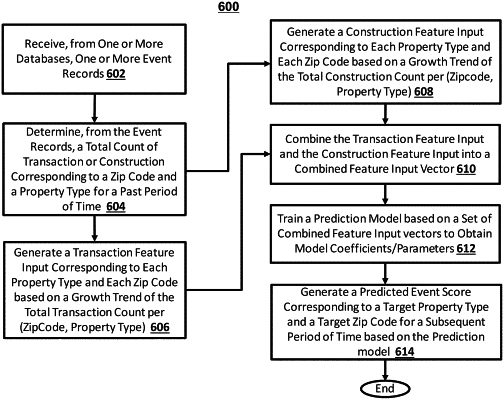| CPC G06Q 30/0205 (2013.01) [G06N 20/00 (2019.01); G06Q 40/06 (2013.01); G06Q 50/08 (2013.01); G06Q 50/16 (2013.01)] | 18 Claims |

|
1. A method for generating an on-demand message to a user device for predicting capital crowding of transaction events in a geographical area covered by a plurality of zip codes using a neural network based prediction model, the method comprising:
receiving, via a communication interface over a network, from one or more remote databases, a plurality of event records in response to a data update demand, wherein each event record indicates one property transaction or one construction event, a respective property type and a respective zip code corresponding to the respective event record;
transforming, by a processor, the plurality of event records into a training dataset of feature input vectors, wherein the transforming comprises:
determining, by the processor, from the plurality of event records, a first count of transaction events and a second count of construction events corresponding to at least a specific zip code and a specific property type that occurred during a first period of time, and
wherein the specific zip code corresponds to at least one of respective property types corresponding to the plurality of event records and the specific zip code corresponds to at least one of respective zip codes corresponding to the plurality of event records;
retrieving a third count of transaction events and a fourth count of construction events corresponding to the specific zip code and the specific property type that occurred during a second period of time prior to the first period of time;
determining by the processor a first growth trend of the first count and a second growth trend of the second count by comparing the first count with the third count and the second count with the fourth count;
generating, for the specific property type and the specific zip code:
a transaction feature input based on the first growth trend corresponding to the specific zip code and the specific property type, and
a construction feature input based on the second growth trend corresponding to the specific zip code and the specific property type;
combining the transaction feature input and the construction feature input into a combined feature input vector corresponding to the specific zip code and the specific property type;
generating a plurality of combined feature input vectors, wherein each combined feature input vector corresponds to a specific combination of a zip code and a property type that are mentioned in the plurality of event records;
storing, at a memory, the plurality of combined feature input vectors;
training, by the processor, the neural network based prediction model stored at a memory, on a training dataset of the plurality of combined feature input vectors;
generating a predicted event score indicating a probability that capital crowding corresponding to a target property type and a target zip code will occur in a subsequent fixed period of time using the trained neural network based prediction model, wherein the target property type and the target zip code are mentioned in the plurality of event records; and
transmitting, via the communication interface and over the network, a capital crowding prediction message of the predicted event score to a user device thereby causing a display of the capital crowding prediction message on a user interface.
|